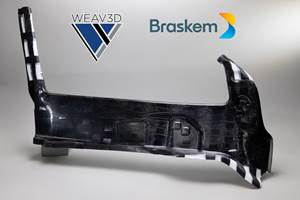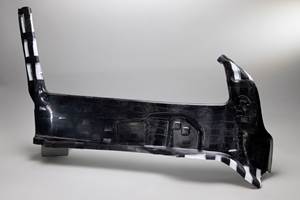A technological brake for the carbon supply roller coaster?
Henrik Olofsson is a co-founder and the business development manager of Oxeon AB (Västra Frölunda, Sweden). He holds an MS in mechanical engineering from Chalmers University of Technology and a BS in business economics and management from the School of Economics and Commercial Law, Gothenburg University (both in
I have followed with interest the discussions regarding affordable PAN-based carbon fiber supply. I believe there is a possible way to increase aerospace-grade carbon fiber output without making large investments in new production facilities.
As noted in previous issues of High-Performance Composites, the production mix is one of the most important factors affecting carbon fiber output. Fiber producers have to set off valuable resources to produce 6K, 3K and even 1K small tows instead of maximizing output by producing 12K. From discussions I've had with many industry players, I understand that the main reason to use a small tow is the thinner and lighter areal weight characteristics it brings to a woven fabric. Compared to a 12K woven fabric, a smaller tow fabric has the advantages of lower areal weight and less crimp (i.e., waviness) in the structure and, therefore, improved surface smoothness and better mechanical performance in a composite structure.
But a woven fabric made from fibrous tapes, instead of smaller tows or yarns, has those same advantages. Dr. Nandan Khokar, cofounder and R&D manager of Oxeon AB, during his work at Chalmers University of Technology (Gothenburg, Sweden), developed a patented weaving technology that processes 20-mm to 50-mm (0.79-inch to 1.97-inch) wide warp and weft spread carbon fiber tapes to produce fabrics. Large tows, such as 12K or 24K, are spread into flat tapes — the wider the spread, the thinner the tape, with a corresponding decrease in areal weight. When a woven reinforcement is made by weaving spread tows or tapes instead of standard tows, the incidence of crimp is significantly reduced. A test carried out by the University in partnership with the Swedish Institute of Composites (SICOMP) compared a traditional fabric produced from 3K tows and a tape-woven fabric produced from spread 12K tows. The mechanical performance of the tape fabric was shown to be better than the 3K fabric. Fiber properties of the 3K and 12K carbon were identical. Others have observed similar results and resulting improved performance, such as that presented at Aeronautics Forum at this year's JEC Composites Show in Paris, in "Thin Ply Technology for More Effective & Optimum Design." Presented by Stephen W. Tsai, professor emeritus of Stanford University, the paper was encouraging in that Prof. Tsai indicated qualification of spread tape woven materials is underway and may not be prohibitively expensive.
Several material suppliers have produced similar woven tape products and converted them into prepregs, including Cytec Engineered Materials Inc. (Tempe, Ariz.), Toray Composites America Inc. (Tacoma, Wash.) and Hexcel (Dublin, Calif.). Cytec's material, woven by Fabric Development Inc. (Quakertown, Pa.), was impregnated with a PEEK thermoplastic resin and used for landing gear doors and access panels on the F-22. Toray's T700S 12K plain-weave fabric has the same areal weight as a 3K fabric, and also is pre-impregnated with an epoxy resin and used extensively in the general aviation market. Hexcel's product is available as a 177°C-/350°F-cure prepreg. More recently, a Japanese company named Technomax has developed a method of spreading fibers with ultrasonic energy and weaving the resulting spread fibers in an economical way, with an eye toward producing recyclable thermoplastic prepregs.
Economically, the method holds promise if tows can be both spread and woven quickly and efficiently. Unlike traditional weaving, tape weaving requires no setting equipment and setup time is significantly reduced, in my experience. Production rates are higher because warp and weft tapes are four to ten times wider than 12K tow. More importantly, fiber producers can increase output using existing facilities by producing more 12K tows instead of the smaller sizes. The investment in a fiber spreading line is insignificant compared to investment in a new carbon fiber production plant. Fiber producers could spread the tows directly as they emerge from the spinerettes and thereby add greater value to the spread tow product without major capital investments.
I invite carbon fiber producers to consider this approach. It could not only help maintain consistent carbon fiber supply for the entire industry, but also improve mechanical performance of woven materials in high-performance applications using a lower-cost fiber. In this way we may be able to reduce the "roller coaster" effect of past fiber shortages and cost increases.
Related Content
Braskem demonstrates PP solutions using Weav3D composite lattice technology
Partnership combines Braskem’s polypropylene sheets with Weav3D Rebar for Plastics technology to address new structural, automotive applications requiring high-strength, lightweight material solutions.
Read MorePlant tour: Albany Engineered Composites, Rochester, N.H., U.S.
Efficient, high-quality, well-controlled composites manufacturing at volume is the mantra for this 3D weaving specialist.
Read MorePEEK vs. PEKK vs. PAEK and continuous compression molding
Suppliers of thermoplastics and carbon fiber chime in regarding PEEK vs. PEKK, and now PAEK, as well as in-situ consolidation — the supply chain for thermoplastic tape composites continues to evolve.
Read MoreHighly tunable, woven lattice reinforcements target automotive structures
CAMX 2023: Startup Weav3D will be demonstrating its two collaborative automotive demonstrator parts and present two conference papers.
Read MoreRead Next
Developing bonded composite repair for ships, offshore units
Bureau Veritas and industry partners issue guidelines and pave the way for certification via StrengthBond Offshore project.
Read More“Structured air” TPS safeguards composite structures
Powered by an 85% air/15% pure polyimide aerogel, Blueshift’s novel material system protects structures during transient thermal events from -200°C to beyond 2400°C for rockets, battery boxes and more.
Read MoreAll-recycled, needle-punched nonwoven CFRP slashes carbon footprint of Formula 2 seat
Dallara and Tenowo collaborate to produce a race-ready Formula 2 seat using recycled carbon fiber, reducing CO2 emissions by 97.5% compared to virgin materials.
Read More











.jpg;maxWidth=300;quality=90)









